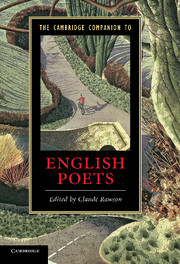Book contents
- Frontmatter
- Introduction
- 1 Geoffrey Chaucer
- 2 Thomas Wyatt
- 3 Edmund Spenser
- 4 William Shakespeare
- 5 John Donne
- 6 Ben Jonson
- 7 George Herbert
- 8 John Milton
- 9 Andrew Marvell
- 10 John Dryden
- 11 Jonathan Swift
- 12 Alexander Pope
- 13 William Blake
- 14 Robert Burns
- 15 William Wordsworth
- 16 Samuel Taylor Coleridge
- 17 George Gordon, Lord Byron
- 18 Percy Bysshe Shelley
- 19 John Keats
- 20 Alfred Lord Tennyson
- 21 Robert Browning
- 22 Emily Brontë
- 23 Christina Rossetti
- 24 Thomas Hardy
- 25 William Butler Yeats
- 26 D. H. Lawrence
- 27 T. S. Eliot
- 28 W. H. Auden
- 29 Philip Larkin
- Further Reading
- Index
22 - Emily Brontë
Published online by Cambridge University Press: 28 May 2011
- Frontmatter
- Introduction
- 1 Geoffrey Chaucer
- 2 Thomas Wyatt
- 3 Edmund Spenser
- 4 William Shakespeare
- 5 John Donne
- 6 Ben Jonson
- 7 George Herbert
- 8 John Milton
- 9 Andrew Marvell
- 10 John Dryden
- 11 Jonathan Swift
- 12 Alexander Pope
- 13 William Blake
- 14 Robert Burns
- 15 William Wordsworth
- 16 Samuel Taylor Coleridge
- 17 George Gordon, Lord Byron
- 18 Percy Bysshe Shelley
- 19 John Keats
- 20 Alfred Lord Tennyson
- 21 Robert Browning
- 22 Emily Brontë
- 23 Christina Rossetti
- 24 Thomas Hardy
- 25 William Butler Yeats
- 26 D. H. Lawrence
- 27 T. S. Eliot
- 28 W. H. Auden
- 29 Philip Larkin
- Further Reading
- Index
Summary
Ted Hughes, born and bred in West Yorkshire like Emily Brontë, was haunted by her memory. His poetic engagement with her life is stamped with his own creative personality, but in its focus on her singleness, her devotion to the wild moorland, her passionate secrecy, and her early death it draws together the central points of a widely shared perception of Brontë’s character as a writer:
The wind on Crow Hill was her darling.
His fierce, high tale in her ear was her secret.
But his kiss was fatal.
As Hughes sees it, Brontë’s life was inseparable from a dark affinity with natural energies. The erotic intensity of this connection gave her a unique voice, but also made it impossible for her to live: ‘Her death is a baby-cry on the moor.’ The popularity of that literary image – Emily Brontë as a free, rebellious spirit, close to nature, and doomed to die young – has given her the status of a kind of anti-Victorian woman, celebrated for her defiance of the conventions of the drawing room. Her admirers, including many who have never read a word of her writing, feel that they know her intimately. She has become a myth.
Remarkably few solid facts about Emily Brontë’s life have survived, so that legends have had plenty of room to grow. There is no extensive body of letters, journals, manuscripts, or juvenilia. Three formal notes, addressed to a friend of her sister Charlotte, were preserved, together with several essays written while she was studying in Brussels, four widely spaced ‘diary papers’, part of an account book, and a few other desultory scraps.
- Type
- Chapter
- Information
- The Cambridge Companion to English Poets , pp. 408 - 421Publisher: Cambridge University PressPrint publication year: 2011

